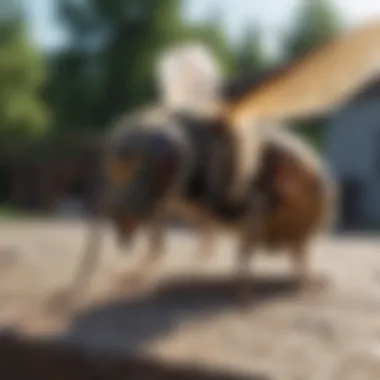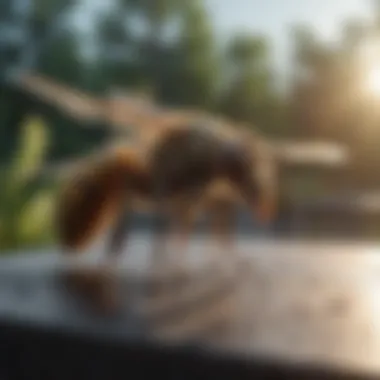Expert Strategies for Effectively Detering Hornets from Nesting Around Your Property


Preventive Pest Control Strategies
When it comes to safeguarding your home against pest invasions, employing preventive pest control strategies is paramount. Starting with the house's exterior protection, sealing cracks and crevices is essential to prevent pests like hornets from finding entry points into your abode. Clearing debris from outdoor spaces not only enhances the aesthetic appeal but also eliminates hiding spots for potential intruders. Moreover, implementing measures to keep pests at bay, such as installing screens on windows and doors, significantly reduces the likelihood of hornet infestations.
Yard Maintenance
Maintaining a well-groomed yard is not only aesthetically pleasing but also serves as a deterrent for pests, including hornets. Essential yard care routines like regular mowing, pruning, and weeding disrupt the habitat of hornets, making your outdoor space less attractive to them. Employing methods such as removing standing water, which acts as a breeding ground for insects, and using natural pest control solutions like neem oil can further enhance your yard's pest-free environment.
Indoor Cleanliness
Indoor cleanliness plays a vital role in pest prevention, including deterring hornets from nesting inside your home. Expert cleaning tips and techniques involve regular dusting, vacuuming, and decluttering to eliminate potential hiding places for pests. Maintaining a pest-resistant indoor environment also includes proper food storage, prompt garbage disposal, and sealing cracks around baseboards and entry points to prevent hornets from infiltrating your living spaces.
Garbage Disposal
Efficient waste disposal methods are crucial in preventing pest infestations, including hornets. Proper garbage disposal not only eliminates food sources that attract pests but also reduces the risk of odors that can lure hornets near your home. Use trash cans with secure lids, empty them regularly, and clean them to remove any food residues that might attract unwanted pests. Additionally, recycling bins should be kept clean and tightly sealed to prevent hornets from scavenging for food.
Other Pest Prevention Strategies
Innovative ways to safeguard your home from hornets and other pests involve implementing a combination of physical barriers, natural repellents, and pest surveillance. Installing barriers like mesh screens on vents and chimneys prevents hornets from accessing your home's interior. Using natural repellents such as peppermint oil or citrus sprays can deter hornets while being safe for the environment. Regularly inspecting your property for signs of pest activity and addressing them promptly is paramount in effective pest prevention.
Understanding Hornets


Hornets play a significant role in the ecosystem, yet their presence near human habitation can pose serious risks. Understanding hornets' habitat and behavior is crucial for effectively preventing infestations. By observing their nesting patterns and dietary preferences, homeowners can proactively deter these insects from settling on their property. Recognizing key characteristics of hornets such as their aggressiveness and territorial nature is essential for implementing successful prevention strategies
Habitat and Behavior of Hornets
Diet and Nesting Patterns
Delving into hornets' diet sheds light on their nesting preferences. Hornets are carnivorous insects that primarily feed on other insects and sap. This dietary choice influences their nest location, as they seek areas abundant in prey for sustenance. Understanding this aspect is vital as it guides homeowners to remove attractants like food debris and stagnant water near their property, reducing the likelihood of hornet infestations.
Identification of Hornets
Identifying hornets accurately is a critical step in effective prevention. Differentiating hornets from other stinging insects like wasps is essential for applying targeted control measures. Hornets have distinct physical features, including their size, coloring, and characteristic buzzing sound. Being able to recognize these unique traits enables homeowners to act swiftly upon detecting hornet presence, mitigating potential risks.
Potential Risks Associated with Hornet Nests
Stings and Allergic Reactions
One of the primary dangers of hornet nests is the risk of stings, which can cause severe allergic reactions in sensitive individuals. Understanding the consequences of hornet stings emphasizes the importance of proactive nest prevention. By realizing the potential health threats posed by hornets, homeowners are motivated to implement preventive measures to safeguard their family and pets.
Property Damage
Hornet nests can lead to structural damage to buildings and outdoor spaces. Their nesting behaviors, such as chewing wood to construct hives, can compromise the integrity of structures over time. Recognizing this risk underscores the urgency of preventing hornet infestations. Protecting property from potential damages by addressing nest presence promptly is key in maintaining a secure and well-maintained living environment.


Preventative Measures
Sealing Entry Points
Inspecting Exterior of Buildings
Inspecting the exterior of buildings plays a vital role in preventing hornets from nesting. By carefully examining the outer areas of your property, you can identify potential entry points. These could be cracks, crevices, or openings that hornets may exploit to build their nests. Inspecting thoroughly allows you to discover these vulnerabilities before they turn into a significant issue. Being proactive in examining the building's exterior is crucial for maintaining a hornet-free environment.
Repairing Cracks and Gaps
Repairing any cracks and gaps found during the inspection is essential for effective hornet prevention. By sealing off these entry points, you eliminate potential nesting sites for hornets. This step goes a long way in fortifying your property against hornet infestations. Repairing cracks and gaps not only deters hornets but also enhances the overall structural integrity of your building. While this task may require some effort, the long-term benefits of a hornet-free environment are definitely worthwhile.
Maintaining Cleanliness
Proper Waste Management
Proper waste management is a key aspect of hornet prevention. Ensuring that garbage bins are tightly sealed and disposing of waste regularly reduces the likelihood of attracting hornets. By eliminating food sources around your property, you discourage hornets from considering it as a potential nesting site. Proper waste management contributes significantly to creating an environment that is unappealing to hornets.
Regular Cleaning of Outdoor Areas
Regularly cleaning outdoor areas is essential for hornet prevention. Remove any debris or clutter that could provide hiding spots for hornets. By keeping your outdoor spaces clean and clutter-free, you reduce the chances of hornets finding suitable locations to build their nests. Consistent cleaning not only deters hornets but also enhances the overall aesthetics and hygiene of your property.


Natural Deterrents
Planting Insect-Repelling Herbs
Planting insect-repelling herbs is a natural and effective way to deter hornets. Herbs like mint, citronella, and basil emit scents that repel not only hornets but other insects as well. By incorporating these herbs into your garden or outdoor landscape, you create a natural barrier against hornets. The added benefit of these herbs is that they contribute to a greener and more fragrant environment.
Creating Bird-Friendly Spaces
Creating bird-friendly spaces serves as a strategic approach to hornet prevention. Birds like sparrows and swallows are natural predators of hornets, preying on them for food. By setting up bird feeders, bird baths, or birdhouses, you attract these avian hunters to your property. Birds help in keeping the hornet population in check, reducing the likelihood of nests being established. Creating bird-friendly spaces not only aids in hornet prevention but also adds a touch of natural beauty and wildlife to your surroundings.
Professional Interventions
Professional interventions play a crucial role in effectively managing hornet infestations. Seeking pest control services is a strategic approach to address hornet nesting problems comprehensively. By consulting experienced exterminators, you gain access to specialized knowledge and skills in handling hornet infestations, ensuring a more targeted and efficient eradication process. Experienced exterminators possess the expertise to identify hornet nests, determine the best course of action, and execute removal procedures with precision and safety measures in mind. Their experience in dealing with various pest infestations equips them with valuable insight into hornet behavior and nest locations, leading to more effective outcomes. Choosing professional services for hornet control guarantees a thorough and professional approach, minimizing risks and ensuring long-term prevention strategies are in place. Implementing safe removal practices is another critical aspect of pest control services. By following industry-standard safety protocols, such as using protective gear and environmentally friendly removal techniques, exterminators mitigate potential hazards associated with hornet nest removal. Safe removal practices not only protect homeowners and pets from stings but also contribute to environmental sustainability by utilizing eco-conscious methods. Emphasizing safe removal practices underscores the commitment to effective and responsible pest management, prioritizing the well-being of occupants and the ecosystem.
Seeking Pest Control Services
Consulting Experienced Exterminators: Consulting experienced exterminators is a prudent choice when addressing hornet infestations due to their specialized knowledge and hands-on experience in pest control. Experienced exterminators possess a deep understanding of hornet behavior, allowing them to identify nesting sites accurately and implement targeted eradication techniques. Their expertise in utilizing environmentally friendly solutions and minimizing collateral damage ensures a safe and effective removal process. The advantage of consulting experienced exterminators lies in their ability to deliver tailored solutions tailored to the specific needs of each infestation, enhancing the overall efficacy of pest control efforts. However, the reliance on professional services may entail higher costs compared to DIY approaches, requiring homeowners to weigh the benefits of expert intervention against budget considerations.
Implementing Safe Removal Practices: Implementing safe removal practices is essential in ensuring the humane and environmentally conscious eradication of hornet nests. By adhering to established safety guidelines and utilizing non-toxic removal methods, exterminators can effectively eliminate hornet populations without causing harm to beneficial insects or wildlife. The use of protective equipment, such as bee suits and face shields, safeguards exterminators from potential stings during the removal process, minimizing health risks. Additionally, integrating safe removal practices into pest control services promotes sustainable pest management practices that support biodiversity and ecological balance. While safe removal practices contribute to enhancing safety and minimizing environmental impact, they may require specialized training and equipment, potentially affecting service costs and operational timelines.
Installing Hornet Traps
Placement and Effectiveness of Traps: The strategic placement of hornet traps is instrumental in capturing hornets and disrupting their nesting activities effectively. By situating traps near potential nesting sites, such as eaves, trees, or garden sheds, homeowners can intercept foraging hornets and prevent them from establishing colonies near their property. The effectiveness of traps relies on factors like bait attractiveness, trap design, and location optimization. Utilizing pheromone-based baits increases trap efficiency by attracting hornets seeking food sources, leading to higher capture rates. Understanding the foraging patterns of hornets is key to placing traps in high-traffic areas, improving their efficacy in reducing hornet populations. While hornet traps offer an environmentally friendly and non-invasive solution to pest control, their effectiveness may vary depending on environmental conditions and hornet species present in the area.
Types of Hornet Traps Available: Various types of hornet traps are available in the market, each designed to target specific hornet species and nesting behaviors. From bottle traps to hanging traps, homeowners can choose from a range of trap models that cater to their property's unique needs and hornet population density. Different traps employ diverse trapping mechanisms, such as entry funnels, sticky surfaces, or liquid baits, to capture hornets effectively. Selecting the right type of hornet trap depends on factors like trap capacity, durability, and maintenance requirements, ensuring long-term efficacy in hornet control efforts. While hornet traps offer a cost-effective and low-maintenance solution for managing hornet populations, homeowners should consider factors like trap placement and replacement intervals to optimize trap performance and maximize control outcomes.
Regular Monitoring and Maintenance Regular monitoring and maintenance are pivotal aspects of hornet nest prevention, ensuring a safe and secure environment. By consistently checking for signs of nesting, you can proactively address potential issues before they escalate. This proactive approach not only saves time and effort in the long run but also prevents the risks associated with fully developed hornet nests. Additionally, regular maintenance of your property, such as repairing cracks and gaps, further reduces the likelihood of hornets finding conducive nesting spots. Taking these preventive measures significantly decreases the chances of hornet infestations and promotes a peaceful living environment. Periodic Inspections Under the umbrella of regular monitoring, periodic inspections play a crucial role in maintaining a hornet-free space. When checking for nesting signs, be thorough in examining common hornet nesting areas like eaves, trees, and shed roofs. Look for distinct indicators such as hexagonal cells, buzzing sounds, and an increase in hornet activity. Prompt action upon detecting these signs is essential to prevent the nest from growing. Act swiftly to remove any found nests using safe practices or seek professional assistance if needed for effective nest removal. Immediate Action Upon Detection After spotting signs of hornet nesting, immediate action is key to nip the issue in the bud. Quickly address the situation by safely eliminating the nest or contacting pest control services for expert intervention. Timely removal ensures that hornet colonies do not mature, minimizing the chances of stings and property damage. Acting promptly also deters hornets from establishing a presence on your property, contributing to a harmonious and hornet-free living environment.



